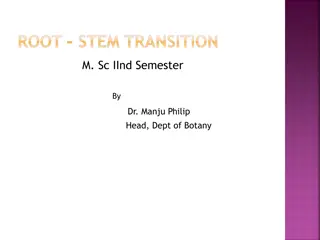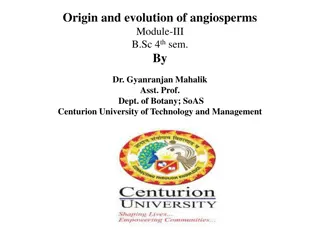Understanding Vascular Transition in Root-Stem Structure
Root and stem in plants form a continuous structure with a transition region between them. The transition involves twisting and inversion of xylem strands, leading to variations in vascular bundles. Eames and Mac Daniels identified different types of vascular transitions in dicots and monocots, each
1 views • 13 slides
Understanding Secondary Growth in Plants: Boerhaavia (Dicot) vs. Dracaena (Monocot)
Secondary growth, resulting from cambial cell division, thickens stems and roots in plants. This process involves cambium, a tissue layer between xylem and phloem, responsible for secondary growth. Cambium ray initials give rise to vascular rays and secondary xylem/phloem. The seasonal activity of c
0 views • 24 slides
Origin and Evolution of Angiosperms: Insights into Their Phylogenetic Origins
Undisputed fossil records reveal the significant appearance and diversification of angiosperms during the Mesozoic era. The debate on the origin of angiosperms revolves around their monophyletic versus polyphyletic nature. While some argue for a monophyletic origin based on shared characteristics, o
1 views • 5 slides
Understanding Angiosperms: Classification and Reproduction
Angiosperms reproduce sexually through flowers, with their ovaries developing into fruits that protect and disperse seeds. Classification of angiosperms includes monocots and dicots based on the number of seed leaves. They are categorized by characteristics like stem composition and growing seasons
0 views • 4 slides
Understanding Plant Classification and Characteristics
Discover the classification of plants based on their structures and characteristics, including vascular vs. nonvascular plants, seed plants vs. seedless plants, and the definitions of angiosperms, gymnosperms, dicots, and monocots. Learn about the history of plant classification and how plants are g
0 views • 27 slides




